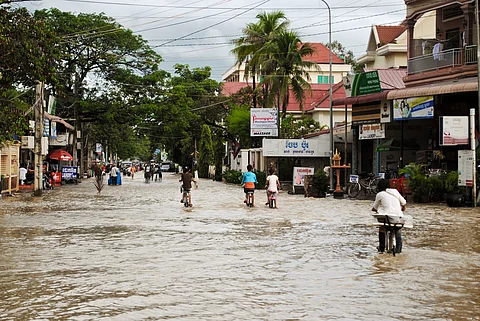

A new United Nations report warned that climate shocks could result in annual economic losses of at least 6 per cent in one-third of Asia-Pacific countries, underlining the region’s acute vulnerability to climate change.
The report, Economic and Social Survey of Asia and the Pacific 2025: Understanding the Macroeconomic Implications of Climate Change, published by the UN Economic and Social Commission for Asia and the Pacific (ESCAP), highlighted that many developing economies in the region are struggling to manage the macroeconomic consequences of climate change and the transition to a green economy. The report was launched on April 8, 2025.
Although the Asia-Pacific region contributed 60 per cent of global economic growth in 2024, several of its countries remain ill-prepared for climate shocks, according to the report.
Among the 30 countries analysed in the survey, 11 were identified as particularly exposed to climate risks from a macroeconomic standpoint. These countries are Afghanistan, Cambodia, the Islamic Republic of Iran, Kazakhstan, the Lao People’s Democratic Republic, Mongolia, Myanmar, Nepal, Tajikistan, Uzbekistan and Viet Nam.
Many countries in the region regularly experience losses in gross domestic product (GDP) as a result of extreme weather events. The report specifically examines the estimated average annual loss (AAL) due to climate-related factors as a percentage of GDP.
These losses are closely linked to a combination of intensifying climate hazards, vulnerable infrastructure, economic and sectoral exposure — especially in agriculture, energy and manufacturing — and rapid urbanisation alongside land-use changes.
In terms of climate hazards, the increasing frequency and severity of extreme events such as floods, droughts, heatwaves and tropical cyclones are key drivers of economic losses.
The ESCAP Asia-Pacific Risk and Resilience Portal provides data on the AAL for economies in the region. The AAL represents the estimated annual economic loss from disasters, based on probabilistic risk assessments that account for hazard frequency, intensity, exposure and vulnerability.
For the 30 countries analysed, the AAL as a share of GDP is estimated at around 4.8 per cent. In Cambodia, AAL reaches nearly 11 per cent of GDP. In Fiji, Myanmar and Pakistan, AAL stands at a minimum of 7 per cent of GDP.
Cambodia’s high losses were attributed to extreme floods and droughts that disrupt agriculture. In Fiji, Myanmar and Pakistan, weak infrastructure exacerbates the impact of disasters. Viet Nam’s vulnerability is intensified by rapid urbanisation and changes in land use, which heighten exposure to coastal flooding and storms.
To ensure sustainable economic growth, the report called for proactive government intervention to support the transition into more productive and higher-income sectors. The region was also urged to leverage its competitive strengths in green industries and value chains as new drivers of economic growth.
In order to secure long-term prosperity, the survey emphasised the importance of inclusive regional economic cooperation that meets the development needs of both developed and developing countries.